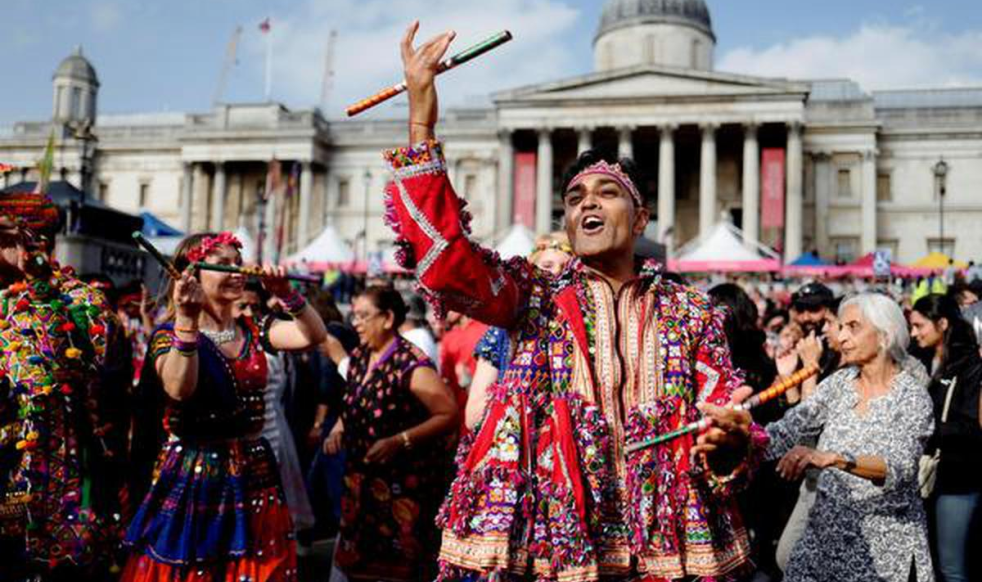British Indians are citizens of the United Kingdom (UK) whose ancestral roots are from India. This includes people born in the UK who are of Indian origin as well as Indians who have migrated to the UK. Currently, the British Indian population exceeds 1.8 million people in the UK, making them the single largest visible ethnic minority population in the country. They make up the largest subgroup of British Asians and are one of the largest Indian communities in the Indian diaspora, mainly due to the Indian–British relations (including historical links such as India having been part of the British Empire and still being part of the Commonwealth of Nations). The British Indian community is the sixth largest in the Indian diaspora, behind the Indian communities in the United States, Saudi Arabia, the United Arab Emirates, Malaysia and Nepal. The majority of British Indians are of Punjabi, Gujarati, Bengali and Malayali descent, with smaller Tamil, Telugu, Konkani, and Marathi communities.
Rishi Sunak, a British-Indian himself, is the current Prime Minister of the United Kingdom since 25 October 2022, the first person from an ethnic minority in history to become prime minister.
People from India have settled in Great Britain since the East India Company (EIC) recruited lascars to replace vacancies in their crews on East Indiamen whilst on voyages in India. Initially, these were men from the Indo-Portuguese or Luso-Asian communities of the subcontinent, including men from Bombay, Goa, Cochin, Madras and the Hugli River in Bengal. Later men from Ratnagiri were hired. Many were then unable to obtain passage back due to the price and had no alternative than to settle in London. There were also some ayahs, domestic servants and nannies of wealthy British families, who accompanied their employers back to Britain when their stay in South Asia came to an end. British soldiers would also sometimes marry Indian women and send their children back to Britain, although the wife often did not accompany them. Indian wives of British soldiers would sometimes ask for passage home after being divorced or widowed if they did accompany their children. In 1835, the husband (a British soldier serving in His Majesty's 1st Foot Regiment) of Bridget Peter, a native of Madras, died. She petitioned the Directors from Chelsea Hospital 'in a state of destitution' to pay for her return to India. They agreed to pay to return her and her three children.
The first Western educated Indian to travel to Europe and live in Britain was I'tisam-ud-Din, a Bengali Muslim cleric, munshi and diplomat to the Mughal Empire who arrived in 1765 with his servant Muhammad Muqim during the reign of King George III. He wrote of his experiences and travels in his Persian book, Shigurf-nama-i-Wilayat (or 'Wonder Book of Europe'). This is also the earliest record of literature by a British Indian. Also during the reign of George III, the hookah-bardar (hookah servant/preparer) of James Achilles Kirkpatrick was said to have robbed and cheated Kirkpatrick, making his way to England and stylising himself as the Prince of Sylhet. The man was waited upon by the Prime Minister of Great Britain William Pitt the Younger, and then dined with the Duke of York before presenting himself in front of the King.
The Navigation Act 1660 restricted the employment of non-English sailors to a quarter of the crew on returning East India Company ships. Baptism records in East Greenwich suggest that a small number of young Indians from the Malabar Coast were being recruited as house servants at the end of the 17th century, and records of the EIC also suggest that Indo-Portuguese cooks from Goa were retained by captains from voyage to voyage. In 1797, 13 were buried in the parish of St Nicholas at Deptford.
During the 19th century, the East India Company brought thousands of Indian lascars, scholars and workers to Britain largely to work on ships and in ports. Some of whom settled down and took local British wives, partly due to a lack of Indian women in Britain and also abandonment due to restrictions on South Asian crew members being employed on British ships such as the Navigation Acts. It is estimated 8,000 Indians (a proportion being lascar sailors) lived in Britain permanently prior to the 1950s. Due to the majority of early Asian immigrants being lascar seamen, the earliest Indian communities were found in port towns. Naval cooks also accompanied them.
One of the most famous early Indian immigrants to Britain was Sake Dean Mahomet, a captain of the British East India Company and a native of Patna in the Indian state of Bihar. In 1810, he founded London's first Indian restaurant, the Hindoostanee Coffee House. He is also valued for introducing shampoo and therapeutic massage to the United Kingdom. Another early Indian to settle in the United Kingdom was the Mughal noblewoman of Purnea in Bihar, Elizabeth Sharaf un-Nisa, who married into the aristocratic Ducarel family and moved to the United Kingdom in 1784 where she lived until 1822 when she died in Newland, Gloucestershire.
By the mid-19th century, more than 40,000 Indian seamen, diplomats, scholars, soldiers, officials, tourists, businessmen and students had travelled to Britain, the majority of them being seamen working on ships, Lascars lodged in British ports in between voyages. Most Indians during this period would visit or reside in Britain temporarily, returning to India after months or several years, bringing back knowledge about Britain in the process.
In the 2021 Census, 1,864,318 people in England and Wales were recorded as having Indian ethnicity, accounting for 3.1% of the population. In Northern Ireland, the equivalent figure was 9,881, or 0.5% of the population. The census in Scotland was delayed for a year and took place in 2022; ethnicity results for Scotland are expected to be published in late 2023 or early 2024.
The 2011 United Kingdom census recorded 1,451,862 residents of Indian ethnicity, accounting for 2.3 per cent of the total UK population (not including those of mixed ethnic backgrounds). The equivalent figure from the 2001 Census was 1,053,411 (1.8 per cent of the total UK population).
People born in India are the UK's largest foreign-born population, totalling an estimated 880,000 in 2020.[31] According to the 2011 census,[32] the cities with the most Indian-born residents are London (262,247), Leicester (37,224), Birmingham (27,206) and Wolverhampton (14,955).
The city or district with the largest population by 'Indian' ethnicity outside the capital, according to the 2021 census in England and Wales, was Leicester (pop. 126,421), followed by Birmingham (66,519), Sandwell (44,378), Wolverhampton (42,052), Coventry (32,096), Slough (30,209), Bolton (26,238), Blackburn with Darwen (24,389), Buckinghamshire (24,181) and Kirklees (22,739). Many of these are however outnumbered by nine London boroughs, namely Harrow, Brent, Hounslow, Hillingdon, Ealing, Redbridge, Newham, Barnet and Croydon.

 3,275 Views
3,275 Views 0 comments
0 comments
Comments